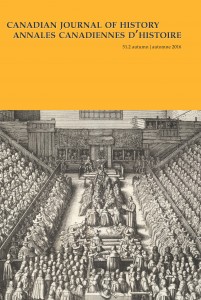Written by guest blogger, Greg Koabel
 In the personal world of early modern politics, political identities were performed by men (for the most part), and mediated through audiences within a shared space and physical immediacy. “The Treasonous Hat” explores just such a contested performance, as the Earl of Strafford fought for his life before an audience of England’s political elite during his treason trial through March and April 1641.
In the personal world of early modern politics, political identities were performed by men (for the most part), and mediated through audiences within a shared space and physical immediacy. “The Treasonous Hat” explores just such a contested performance, as the Earl of Strafford fought for his life before an audience of England’s political elite during his treason trial through March and April 1641.
Strafford’s posture, dress, tone of voice, and behavior were all minutely observed and interpreted by an audience seeking to determine Strafford’s political character — a practice which is not unfamiliar to observers of election campaigns of the 21st century. The nobles, members of parliament, and the crowd of Londoners packed into Westminster Hall to watch the trial were participants in a political world deeply rooted in the physical, encompassing the senses of sight, sound and even — within the crowded scaffolding specially erected for the trial — the senses of touch, taste and smell.
Robert Baillie, a Scotsman watching with hundreds of others within Westminster Hall, complained that “the gravitie [was] not such as I expected”. Rather than an organized and solemn resolution of the kingdom’s affairs Baillie found “oft great clamour without about the doors; in the intervalles, while Strafford was making readie for answers, the Lords gott always to their feet, walked and clattered; the Lower House men too loud clattering; after ten houres much plublict eating, not onlie of confections, bot of flesh and bread, bottles of beer and wine going thick from mouth to mouth without cups, and all this in the King’s eye”. Finally, Baillie lamented that many of his fellow patrons “turned their back, and lett water goe through the formes [benches] they satt on”. Ten hours of eating and drinking, without the ability to leave the closed doors of the hall, forced the realities of the human body into proceedings.
Baillie’s disillusionment with the lack of dignity with which the political elite performed their roles, and the vulgarity of their audience are perhaps familiar in the political world of 2016 as well. Where Baillie might have hoped for the politics of abstract ideas, he found himself in a political world where identities were expressed through, and rooted in, the human body.
Greg Koabel’s article, “The Treasonous Hat: Interpreting Gesture in the Treason Trial of the Earl of Strafford” is available inside Vol. 51, Issue 2 of the Canadian Journal of History/Annales canadiennes d’histoire. Read it at CJH/ACH Online or on Project MUSE.

Comments on this entry are closed.